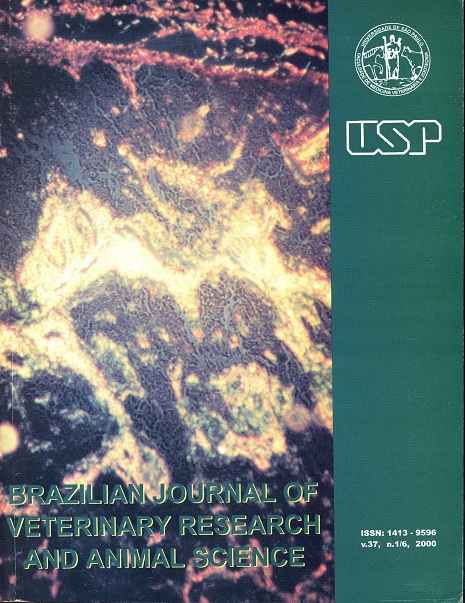Epidemiological aspects of canine dirofilariasis in the metropolitan area of Cuiabá, Mato Grosso: the use of "Immunoblot" and of modified Knott test
DOI:
https://doi.org/10.1590/S1413-95962000000600009Keywords:
Dirofilariasis, Dogs, Epidemiology, ImmunoblottingAbstract
The present research focused on studying, through blood and sorology tests, epidemiological aspects of canine dirofilariasis in the metropolitan area of the city of Cuiabá, Brazil. Blood samples from 822 dogs were tested. The research detected, through "Immunoblot" test, antibodies against adult Dirofilaria immitis antigens in 11.81% of the samples, while 0.41% of the dogs presented, through the modified Knott test, microfilariae of D. immitis. The prevalence of canine dirofilariasis in Cuiabá, in the period between June and November 1977, reached 120.8 case per 1,000 dogs. The "Immunoblot" diagnosed as positive 11.27% of the samples previously tested negative when using the modified Knott test. The research statistically analyzed information on the dogs breed, sex, age and region of origin. It also took into account the possibility that the dogs researched might have traveled to endemic regions, might have been given microfilaricides or might be presenting a compatible symptomatology. The environmental characteristics of the dogs dwelling places were also studied. Dogs from one to nine years old, living in the Center-West region of Cuiabá, were statistically found to be the most affected. The majority of them has not been treated with microfilaricide, and has never left the Cuiabá metropolitan area. They lived, however, in neighborhoods close to streams and/or in houses adjacent to native vegetation. This research was the first time that "Immunoblot" was used for the diagnosis of canine dirofilariasis in Brazil.Downloads
Download data is not yet available.
Downloads
Published
2000-12-01
Issue
Section
VETERINARY MEDICINE
License
The journal content is authorized under the Creative Commons BY-NC-SA license (summary of the license: https://
How to Cite
1.
Fernandes CGN, Rodrigues-Silva R, Moura ST de, Oliveira RMF. Epidemiological aspects of canine dirofilariasis in the metropolitan area of Cuiabá, Mato Grosso: the use of "Immunoblot" and of modified Knott test. Braz. J. Vet. Res. Anim. Sci. [Internet]. 2000 Dec. 1 [cited 2024 May 8];37(6):467-74. Available from: https://revistas.usp.br/bjvras/article/view/5864





